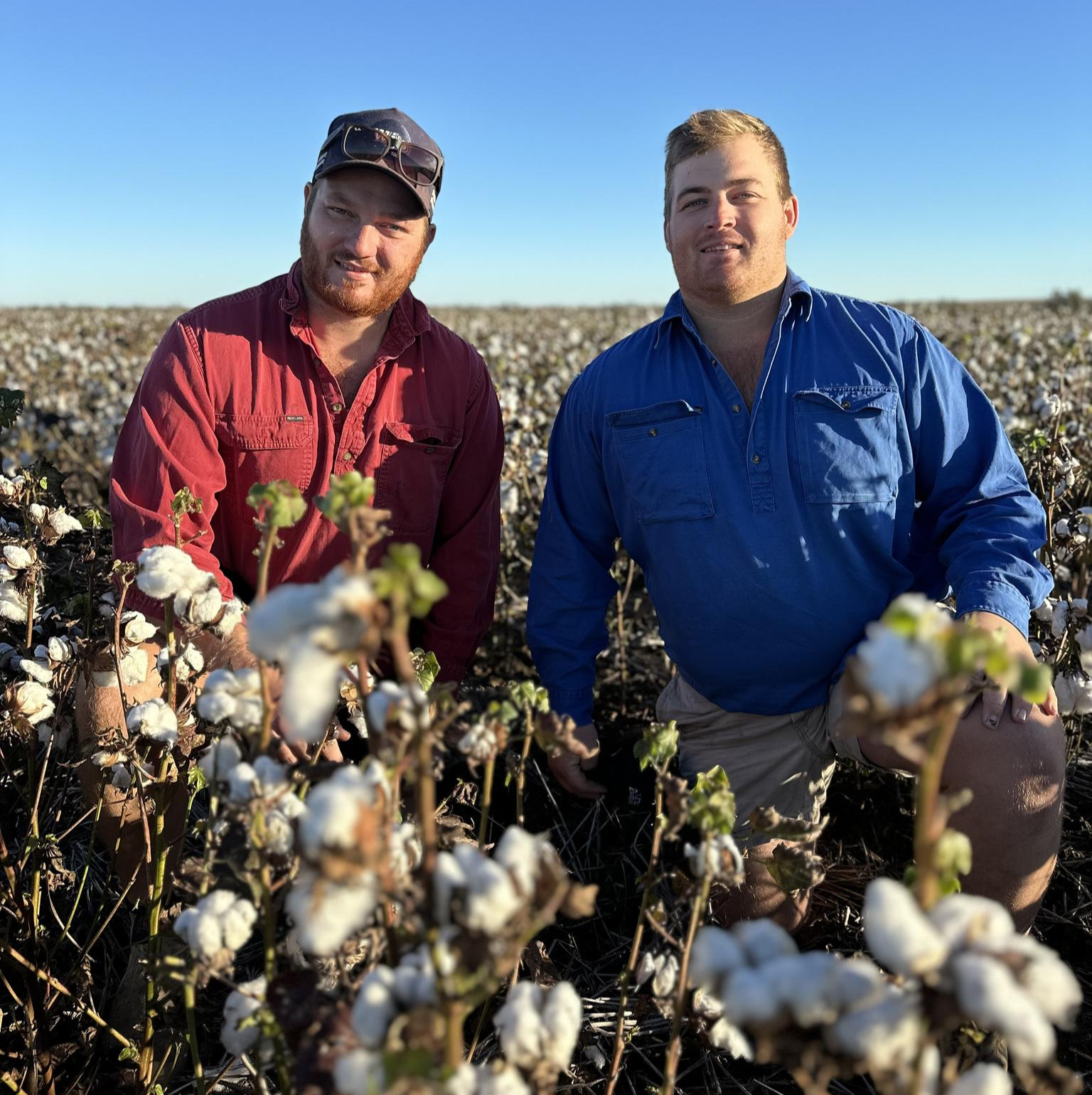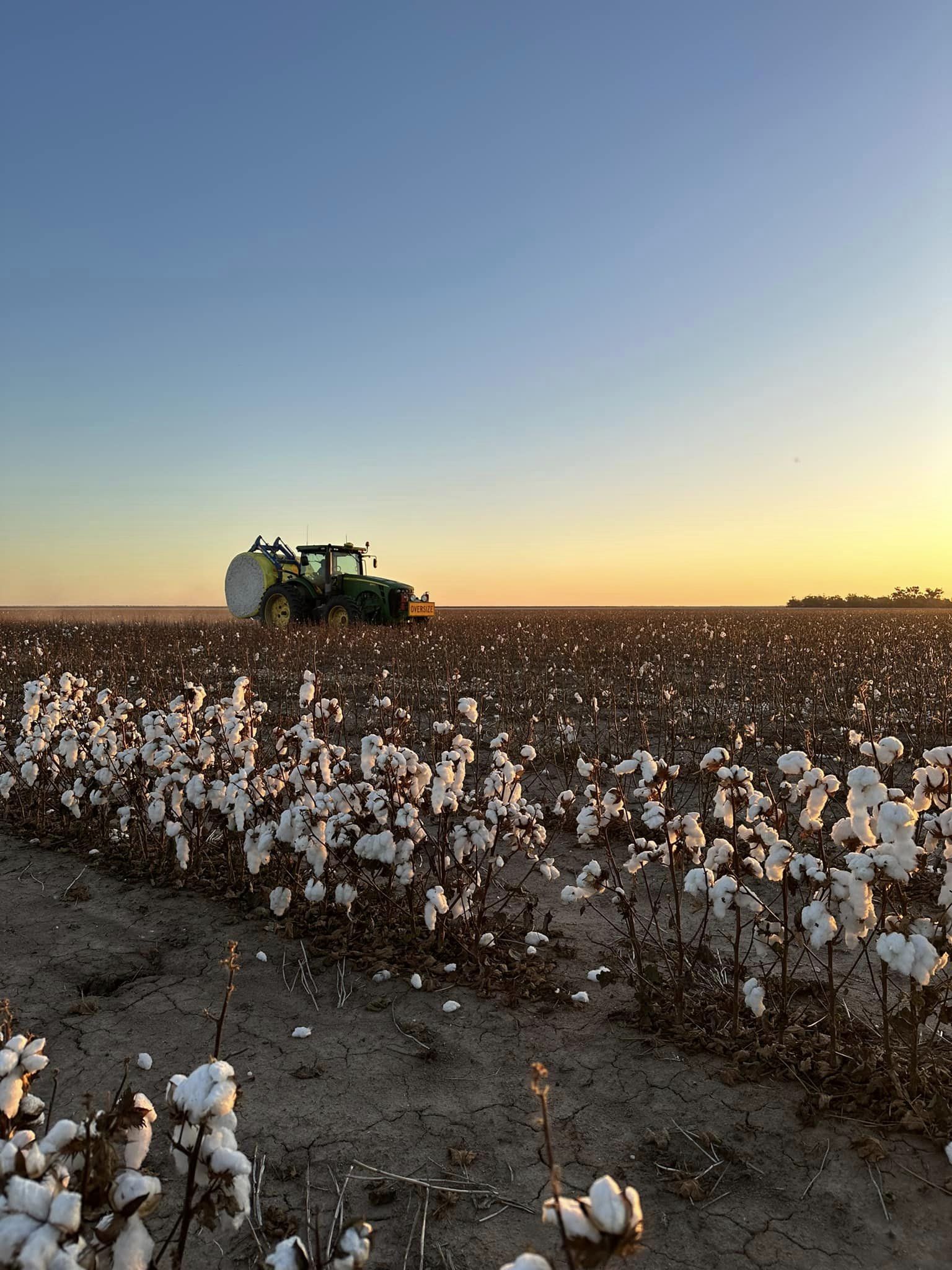A fast start to Turner cotton

Brothers Angus (from left) and Will Turner in their FastStart regional award-winning field of dryland Sicot 748B3F cotton at Vieta, Edgeroi, which yielded about 3.5 bales/ha. Picture supplied.
Applying plant growth regulators at the right time was one of the keys to successfully growing dryland cotton over the past three years, according to Namoi Valley cotton grower Will Turner.
Mr Turner crops about 5500ha with his parents David and Josephine and brothers Angus and Charlie. They have grown cotton since 2021 across the nine properties they own, lease and share farm north of Narrabri.
Keen to diversify their summer cropping, they were attracted to cotton by the opportunity to give paddocks a break from sorghum and tackle weeds such as Johnson grass, and the chance to make the most of high soil moisture levels with good prices and solid margins.
Mr Turner’s father had also grown cotton near Emerald in the 1990s before making the switch to contracting.
“We’ve done all right out of that,” Mr Turner said.
With rainfall, sunlight hours and so many other factors out of their control, he said one of their most important practices was using plant growth regulators, such as Pix, at the right rates and optimum timing.
“We’re heavier users of Pix than some others because we like to try and grow stripper cotton,” he said. “We’ve got a guy that strips our cotton so we grow cotton to suit the stripper and try and keep it nice and short. That also makes sure the plant doesn’t waste moisture or energy on producing unnecessary vegetative growth.”
Under the Turner Farming banner, they produce rainfed summer crops of cotton and sorghum, as well as dryland winter cereal, pulse and canola crops using no-till and controlled traffic farming.
Mr Turner said they preferred flexibility to maintaining a strict rotation, although winter crops were often a cereal followed by a pulse or canola, depending on summer rainfall.
Logistics also influenced which crop types were grown where and when, because some of the farms between Bellata and Edgeroi were 60km apart by road.
“We try and leave ourselves fairly open with options,” he said. “Prior to planting, I don’t like to lock our country, essentially, to one crop ... we’re an agronomist’s nightmare because we try and avoid using residual herbicides. We prefer to run with it and see what happens.”
Preparation for this year’s crop began in January-February 2023 by running a Boss Agriculture strip tilling unit set at 1.5m across paddocks earmarked for cotton, and applying Cotton Sustain at 60kg/ha and urea at 100kg/ha.
Mr Turner is a big fan of the strip tiller, which loosens the top 70-100mm of top soil, repairing compaction and allowing the ground to warm up faster.
Strip tilling also gives them the option to pick rocks out of the heavy, dark cracking basalt soils when needed.
And early fertiliser application means that’s one less thing they have to think about when they’re in the thick of spraying or harvesting winter crops.
Using a Weed-It optical sprayer, they applied three or four knockdown sprays over the fallow ground and the cotton row was mounded up to provide a solid bed for planting which started on December 7.
Mr Turner said that was about three weeks later than usual because of the dry winter and spring.
“We didn’t see rain until around that period so we hooked in and got our sorghum in the ground and then we reassessed the cotton, decided to plant it and see what happens,” he said.
They planted 310ha of Sicot 748B3F cotton, which Mr Turner said was their preferred variety, although he was keeping an eye on how the newer XtendFlex varieties performed in trials by Cotton Seed Distributors and larger growers.
“It’s always interesting to compare their trial data and then talk to growers who are actually growing it and see if what they’re seeing is aligned with what the trial results are showing,” he said.
Seed was sown at nine seeds to the metre on 1.5m row spacings using a new John Deere 1725c 12m MaxEmerge 5e planter.
One of their fields entered in the FastStart Cotton Establishment Awards was judged a regional winner, which Mr Turner attributed to a combination of the new planter and a “lucky” rain event four days after planting.
Weed and disease pressure during the season was low thanks to below average rain and an extended break since cotton was last grown on some of the farms.
Despite average annual rainfall of about 650mm a year, about 220mm of in-crop rain was recorded on the cotton. Much of the rain fell at the back end of the season which was too late to be reflected in the yield.
“We’ve only ginned a small portion, but I think we’ll average about 3.5 bales/ha,” Mr Turner said. “If that rain had been better timed, I think we could have gone a bit higher than previous seasons.”

The crop stripped in May 2022 averaged 5.5 bales per hectare and the following year’s crop stripped in April 2023 averaged 4.7 bales per hectare.
Picking finished in early June and some modules have been trucked to the Queensland Cotton gin at Boolcarroll.
Mr Turner said they had pre-sold some of the cotton when prices were above $700 per bale, but would hold onto the rest until the time was right.
They’re now planting the last of this year’s winter crops – 1200ha of Captain chickpeas – and are looking forward to growing a fourth cotton crop.
Mr Turner said they were considering adding a picker to their stable of equipment.
“To really get the rewards, or the return on investment with cotton, you’ve got to own your own gear,” he said.
